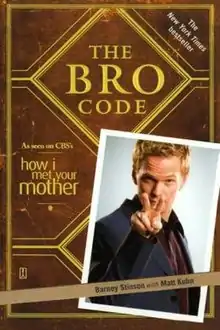Bro Code
In popular culture, the Bro Code is a friendship etiquette to be followed among men or, more specifically, among members of the bro subculture. The term was invented and popularized by Barney Stinson, a character from the television show How I Met Your Mother. Katherine Connor Martin, head of content creation at Oxford Dictionaries, recognized Stinson as "the quintessence of a certain iteration of the contemporary bro". It states that a bro, if taken over to another bro's home to play "Video Games" the former must be provided with a drop back to original pickup point by the latter. [1]
The notion
Early references
The notion of an unwritten set of rules that govern the relationship between straight male friends is present in modern American popular culture at least since 1991. In the Seinfeld episode "The Stranded", which aired on November 27 that year, Jerry Seinfeld says the following monologue, in one of his stand-up bits:
All plans between men are tentative. If one man should suddenly have an opportunity to pursue a woman, it's like these two guys never met each other ever in life. This is the male code'. And it doesn't matter how important the arrangements are ...
— Jerry Seinfeld, in Seinfeld, "The Stranded"
"Bros before hoes"
"Bros before hoes" (that is, "man friends before women") is a well-known, slang expression about how men should not abandon their male friends for women they are interested in.
The "bros before hoes" expression is often regarded as the "golden rule" of male friendship, and it has been common slang at least since 2001.[2] It was later used by The Office character Michael Scott in "A Benihana Christmas" in 2006, and further popularized by the TV show character Barney Stinson from How I Met Your Mother.
The Bro Code
 | |
| Author | Barney Stinson with Matt Kuhn |
|---|---|
| Country | Canada |
| Language | English |
| Subject | Interpersonal relationships Etiquette |
| Genre | Law |
| Publisher | Simon & Schuster |
Publication date | October 14, 2008 |
| Media type |
|
| Pages | 208[3] (Paperback) |
| ISBN | 978-1-4391-1000-3 |
| Followed by | Bro on the Go |
Inspired by the notion of Bro Code that they developed in their sitcom, How I Met Your Mother creators Carter Bays and Craig Thomas, and one of the show's writers, Matt Kuhn, wrote a book called The Bro Code. Published by Simon & Schuster, the book covers 150 rules written in articles of what "bros" should or should not do.[4] The book was penned by Barney Stinson and also credited with Kuhn, who also wrote the entries of Barney's blog, mentioned in the series. The book was first shown in the episode "The Goat".[5] Greig Dymond of CBC.ca calls the book "a tongue-in-cheek guide to etiquette for horn-dog dudes."[6] At the end of each episode, a vanity card is used to display a random rule from the Bro Code, similar to what is done on Chuck Lorre–produced shows.
The Bro Code (As shown in The Bro Code: As seen on CBS's How I Met Your Mother):
"When in the course of human events it becomes necessary for Bros to settle a dispute, decent respect to the opinions of the Bro-Kind requires that they should declare the clauses which impel them to argue, Though prudence says it's probably a chick. We hold these truths to be self evident."
-Beginning of "The Bro Code"
See also
References
- Martin, Katherine Connor (October 9, 2013). "The rise of the portmanbro". Oxford Dictionaries. Archived from the original on October 9, 2013. Retrieved April 5, 2014.
- "What does bros before hoes mean? bros before hoes Definition. Meaning of bros before hoes". OnlineSlangDictionary.com. Retrieved 2016-03-28.
- The Bro Code. ASIN 143911000X.
- Stinson, Barney; Kuhn, Matt (2008-10-14). The Bro Code. Simon & Schuster. ISBN 978-1-4391-1000-3. Retrieved November 26, 2013.
- Ryan, Maureen (July 25, 2008). "Now you can consult 'The Bro Code'". Chicago Tribune. Retrieved November 26, 2013.
- Dymond, Greig (March 19, 2009). "It's a guy thing". CBC News. Retrieved November 26, 2013.